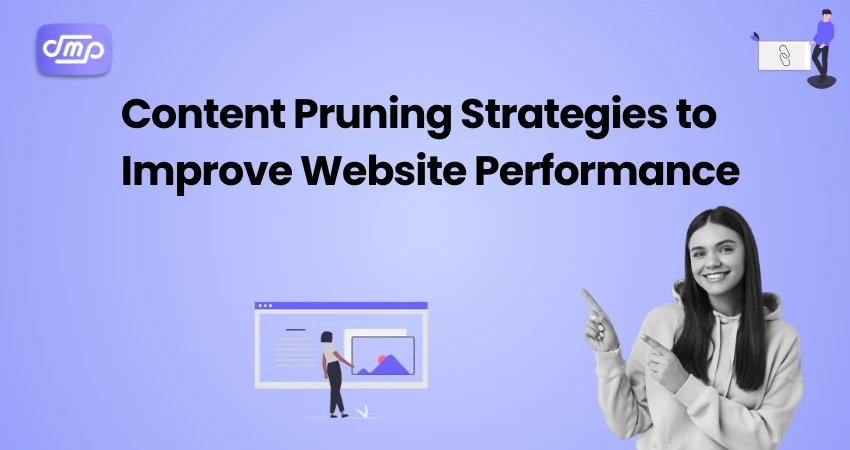
- August 14, 2025
- Digital Marketing, seo
- Digital Marketing, Content Writing
Table of Contents
What is Content Pruning?
Content pruning is the methodical evaluation and removal of old, underperforming, or irrelevant web pages in order to improve a site’s overall quality, SEO performance, and user experience. Rather than allowing poor material to drive down rankings, pruning helps streamline your website, ensuring that only important, relevant pages remain.
In the realm of SEO, maintaining a fresh and relevant website is just as vital as developing new material. This is where content trimming tactics come in. By identifying and removing sites that are no longer relevant to your audience or search engines, you may improve crawl efficiency, keyword rankings, and user experience. When done correctly, content pruning not only improves your website’s appearance but also increases organic traffic and site authority.
Why Content Pruning is Important
In today’s competitive digital market, more material does not always equal better outcomes. In fact, obsolete, irrelevant, or low-quality content might degrade your search rankings and user experience. This is when content trimming tactics become critical.
Search engines such as Google prioritize websites that give up-to-date, relevant, and high-quality content. When your site has old articles, duplicate themes, or sparse material, it can dilute its authority and make it difficult for useful pages to rank.
Implementing content pruning tactics benefits:
- Increase SEO performance by focusing on high-quality, relevant pages.
- Improve the user experience by making sure visitors can find accurate and valuable information fast.
- Improve crawl efficiency so that search engines can properly index your website.
- Increase overall site authority by deleting low-quality material.
- By reducing digital “dead weight,” you allow your top-performing sites to shine, resulting in increased visibility, rankings, and organic traffic.
Signs Your Website Needs Content Pruning

Even the best-kept websites can gather old, irrelevant, or underperforming material over time. Without regular cleanups, this can slowly degrade your SEO performance and user satisfaction. Before using content pruning tactics, it’s critical to identify the red signs that indicate it’s time to act.
- Declining organic traffic: If you notice a consistent reduction in organic traffic despite releasing new material, it’s possible that your site’s old or irrelevant pages are lowering its overall SEO performance. Poorly performing pages might lower your domain authority and make it more difficult for new content to rank.
- High bounce rates: A high bounce rate on specific pages indicates that visitors are not finding the content they expected. This frequently occurs when the content is obsolete, poorly formatted, or irrelevant to the search query. Pruning such content can boost engagement rates and user happiness.
- Outdated or inaccurate. Information: Industries evolve, trends fluctuate, and information become outdated. Having old data, expired deals, or out-of-date references on your website not only reduces trust but also has an impact on rankings. This is a strong indication that certain pages should be updated—or removed entirely—via content pruning procedures.
- Duplicate or overlapping content: When numerous pages target the same topic or keyword, they can compete, resulting in keyword cannibalization. This confuses search engines and may affect rankings. Merging or eliminating overlapping information ensures that your site’s authority is strengthened.
- Thin Content Pages: Pages containing very little helpful information (under 300-500 words) frequently fail to meet user expectations. If they cannot be enhanced with better, more relevant content, pruning them may be the best option.
- Poor Conversion Rates: Some pages may draw traffic but not create leads, sales, or interaction. If optimization techniques do not improve performance, deleting or repurposing the content may be the best option.
- Low Search Engine Rankings for Target Keywords: If specific pages regularly rank low despite optimization, it’s possible that they’re out of date or don’t provide enough value in comparison to competitors. Pruning them frees up your resources to focus on stronger, potentially higher-ranking material.
- Slow website performance: Large amounts of low-value material can slow down site speed, reducing SEO and user experience. Removing unnecessary pages can improve site load times and general health.
Paying attention to these warning indicators can help you determine when to implement content pruning tactics to maintain your site slim, relevant, and SEO-friendly.
Content Pruning Strategies

Using smart content pruning tactics will keep your website relevant, high-performing, and SEO-friendly. Here are the main steps to follow:
- Audit Your Content: Use analytics tools such as Google Search Console, Google Analytics, or Screaming Frog to find pages that are underperforming, outdated, or irrelevant. A thorough audit allows you to identify where your website excels and where it falls short. This is the basis for all successful content reduction operations.
- Determine what to keep, update, merge, or delete: Classify each page depending on its performance and importance. This ensures that your best-performing content receives more attention, while weaker pages do not negatively impact your SEO. Clear decision-making allows you to operate more efficiently without second-guessing your choices.
- Refresh Content Wherever Possible: Instead of eliminating outdated pages, replace them with new data, better images, and re-optimized keywords. This can help to boost ranks and recoup lost traffic. A refresh is often faster and less expensive than producing all new content.
- Merge Similar Content: If you have many articles on the same subject, integrate them into one complete resource. This reduces keyword cannibalization and strengthens ranking power.
- Remove low-value pages: Some content cannot be stored, such as irrelevant announcements, duplicate articles, or extremely short posts. Removing these pages improves the site’s quality and user experience. Always utilize 301 redirects to link visitors to related and relevant information.
- Optimize the remaining content: Once the pruning is complete, make sure the remaining pages are well-structured, readable, and designed. Optimize meta tags, increase internal linking, and employ eye-catching images. This maximizes the effectiveness of your content pruning tactics.
- Review regularly: Make content pruning a regular task—quarterly or biannually is best for most sites. Regular reviews help you identify performance concerns before they worsen. This guarantees that your website remains clean, relevant, and SEO-friendly by following content pruning strategies.
Common Mistakes to Avoid
While using content pruning strategies can considerably improve your website’s SEO and user experience, certain missteps might undo the work. Avoiding these mistakes will prevent you from accidentally harming your rankings or losing essential content.
- Deleting High-Value Pages Without Proper Analysis: One of the most common blunders in content pruning strategies is eliminating pages before fully considering their value. Sometimes, low-traffic content might be beneficial for future campaigns or seasonal patterns. Always consider previous performance, backlinks, and keyword rankings before pruning.
- Ignoring the Impact of Internal Linking: Content pruning strategies inevitably affect your website’s internal linking structure. Removing pages without updating internal links might result in broken links and decreased SEO value. Replace or redirect links from deleted pages to keep the site’s navigation and authority flow intact.
- Over-Pruning and Loss of Topical Authority:Overusing content pruning strategies can cause you to remove too much content, reducing your topical authority. This may reduce your site’s relevancy in the eyes of search engines. Strike a balance between deleting underperforming information and keeping a robust, comprehensive knowledge base.
- Failure to Implement 301 Redirects for Removed Pages: Poor execution of content pruning strategies, such as deleting information without proper redirection, can result in 404 errors that hurt SEO and user experience. Always configure 301 redirects from pruned pages to the most relevant alternative in order to retain link equity and guide users seamlessly.
Conclusion
Content pruning is more than just deleting out-of-date pages; it is about fine-tuning your website to ensure that every piece of content serves a purpose, is relevant to user demands, and supports your SEO objectives. By applying effective content pruning tactics, you may improve search engine rankings, increase user engagement, and create a more authoritative and trustworthy website. Remember that quality always outperforms quantity, so focus on providing valuable, relevant, and up-to-date content that boosts your internet profile.











